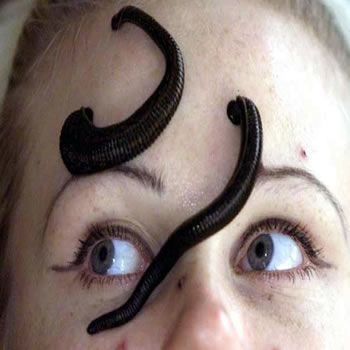
This article was last updated on April 16, 2022
Canada: ![]() Oye! Times readers Get FREE $30 to spend on Amazon, Walmart…
Oye! Times readers Get FREE $30 to spend on Amazon, Walmart…
USA: ![]() Oye! Times readers Get FREE $30 to spend on Amazon, Walmart…
Oye! Times readers Get FREE $30 to spend on Amazon, Walmart…
 Leech therapy is the use of leeches in the treatment ofmedical conditions. Leeches can be thought of as slimy and unattractive creatures, they serve a lot of medical purposes to humans. Since ancient times, leeches were used to treat many illnesses and disease through bloodletting, a method in which blood was drawn out to remove impure blood considering it would heal the body.
Leech therapy is the use of leeches in the treatment ofmedical conditions. Leeches can be thought of as slimy and unattractive creatures, they serve a lot of medical purposes to humans. Since ancient times, leeches were used to treat many illnesses and disease through bloodletting, a method in which blood was drawn out to remove impure blood considering it would heal the body.
Believe it or not, leech therapy is sometimes the best alternative in treating illnesses, and even better than pharmacological treatments. Because of its healingeffects to the human body, this traditional method of curing diseases is still successful today.
For leech therapy, medicinal leeches are grown in a sterile environment in the hospital. There is very small chance of the leeches giving you any type of infection. Even so, you may be given an antibiotic to prevent this. Leeches produce a blood-thinner during leech therapy. The blood-thinner will cause the area to ooze blood for up to 48 hours after the leech is done feeding. Leaches also produce an anesthetic when they bite. This will numb the area being treated.
After leach therapy, fresh blood, rich with oxygen from your lungs, goes to the surgical area. However, the used blood has trouble leaving the area and getting back to your heart and lungs. This causes the area to become blue and cold. Leeches are attached to the discolored, cool area. They suck out the used blood and allow more fresh blood to come and help keep the area healthy. Veins are more fragile and take longer to heal than arteries. Leeches take over the job of your veins during leech therapy. In this way they help give your veins time to heal.
In a leech therapy, your doctor suggests the area to attach leeches. A drop of sugar water or a needle poke helps to attach the leech on the right spot. A fresh drop of blood is helpful for the leech to begin sucking. The placement of the leech will not hurt as leeches secrete a numbing agent. Leeches must not be removed forcefully, they fall off when filled.
Leeches during leech therapy, most often feed for at least 10 minutes and sometimes up to 60 minutes. Each leech will suck about 1-2 teaspoons of blood. Although leeches suck only a small amount of blood, the blood thinner they secrete during the bite will cause blood to ooze for 24-48 hours. After leech therapy your blood will be drawn to check your blood count (hematocrit or hemoglobin) at least twice a day to make sure it is not getting too low.
Once the leeches attach themselves to the skin of the patient and start sucking blood, the saliva enters the puncture site and along with it the enzymes and compounds responsible for all these positive effects. Working together, they act to cure the disease present in the individual. Because of anticoagulation agents, the blood becomes thinner, allowing it to flow freely through the vessels.
The anti-clotting agents also dissolve clots found in the vessels, eliminating the risk of them traveling to other parts of the body and blocking an artery or vein. The vasodilating agents help widen the vessel walls by dilating them, and this causes the blood to flow unconstrained.
In the long run, leech therapy also helps to normalize the blood pressure of hypertensive individuals as well as lessen their risk of suffering from stroke and heart attacks. Blood circulation is also improved with leech therapy and it helps with the healing process of wounds, as well as wounds and lesions caused by diabetes. There is also a noticeable boost in the immune system’s function due to bacteriostatic agents.
Leech therapy is contraindicated to patients with HIV and AIDS. It is also not recommended to patients who are on immunosuppressive drugs. Leech therapy puts these patients at risk for bacterial sepsis, thus, worsening their conditions.
Click HERE to read more from Fashion Central.

Be the first to comment